1、编写一个简单程序,要求数组长度为5,分别赋值10,20,30,40,50,在控制台输出该数组的值。(知识点:数组定义和创建、一维数组初始化)[必做题]
1 package work8; 2 import java.util.Scanner; 3 public class Exercise1 { 4 5 /** 6 * @param args 7 */ 8 public static void main(String[] args) { 9 // 1、编写一个简单程序,要求数组长度为5,分别赋值10,20,30,40,50,在控制台输出该数组的值。(知识点:数组定义和创建、一维数组初始化) 10 Scanner input=new Scanner(System.in); 11 int []a=new int[5]; 12 System.out.println("请给数组赋值为10,20,30,40,50"); 13 for (int i = 0; i < a.length; i++) { 14 a[i]=input.nextInt(); 15 } 16 for (int i = 0; i < a.length; i++) { 17 System.out.println(a[i]); 18 } 19 20 21 } 22 23 }
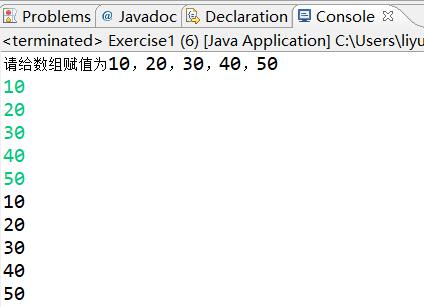
2、将一个字符数组的值(neusofteducation)拷贝到另一个字符数组中。(知识点:数组复制) [必做题]•
1 package work8; 2 3 public class Exercise2 { 4 5 /** 6 * @param args 7 */ 8 public static void main(String[] args) { 9 // 2、将一个字符数组的值(neusofteducation)拷贝到另一个字符数组中。(知识点:数组复制) 10 char []a=new char[]{'c','h','i','n','a'}; 11 char []b=new char[5]; 12 System.out.println("原数组b的值为"); 13 for (int i = 0; i < b.length; i++) { 14 System.out.println(b[i]); 15 } 16 System.arraycopy(a, 0, b, 0, 5); 17 System.out.println("复制后数组b的值为"); 18 for (int i = 0; i < b.length; i++) { 19 System.out.println(b[i]); 20 } 21 22 } 23 24 }
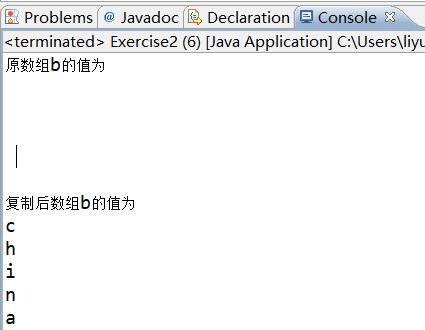
3、给定一个有9个整数(1,6,2,3,9,4,5,7,8)的数组,先排序,然后输出排序后的数组的值。(知识点:Arrays.sort排序、冒泡排序)
1 package work8; 2 3 public class Exercise3 { 4 5 /** 6 * @param args 7 */ 8 public static void main(String[] args) { 9 // 3、给定一个有9个整数(1,6,2,3,9,4,5,7,8)的数组,先排序,然后输出排序后的数组的值。(知识点:Arrays.sort排序、冒泡排序) 10 int []a=new int[]{1,6,2,3,9,4,5,7,8}; 11 java.util.Arrays.sort(a); 12 System.out.println("排序后的数组的值为"); 13 for (int i = 0; i < a.length; i++) { 14 System.out.println(a[i]); 15 } 16 17 } 18 19 }
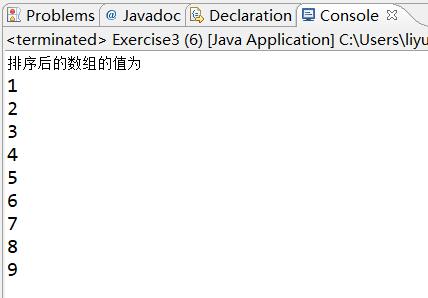
4、 输出一个double型二维数组(长度分别为5、4,值自己设定)的值。(知识点:数组定义和创建、多维数组初始化、数组遍历)
1 package work8; 2 import java.util.Scanner; 3 public class Exercise4 { 4 5 /** 6 * @param args 7 */ 8 public static void main(String[] args) { 9 // 4、 输出一个double型二维数组(长度分别为5、4,值自己设定)的值。(知识点:数组定义和创建、多维数组初始化、数组遍历) 10 Scanner input=new Scanner(System.in); 11 double [][]a=new double [5][4]; 12 for (int i = 0; i < 5; i++) { 13 for (int j = 0; j < 4; j++) { 14 a[i][j]=input.nextDouble(); 15 } 16 } 17 for (int i = 0; i < 5; i++) { 18 for (int j = 0; j < 4; j++) { 19 System.out.print(a[i][j]+" "); 20 } 21 System.out.println(); 22 } 23 24 } 25 26 }
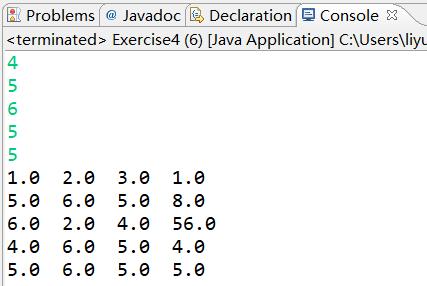
5、 在一个有8个整数(18,25,7,36,13,2,89,63)的数组中找出其中最大的数及其下标。(知识点:数组遍历、数组元素访问) [必做题]•
1 package work8; 2 3 public class Exercise5 { 4 5 /** 6 * @param args 7 */ 8 public static void main(String[] args) { 9 // 5、 在一个有8个整数(18,25,7,36,13,2,89,63)的数组中找出其中最大的数及其下标。(知识点:数组遍历、数组元素访问) 10 int []a=new int[]{18,25,7,36,13,2,89,63}; 11 int max=a[0]; 12 int maxdix=0; 13 for (int i = 1; i < a.length; i++) { 14 if (a[i]>max) { 15 max=a[i]; 16 maxdix=i; 17 } 18 } 19 System.out.println("数组中最大的数为"+max+"该下标为"+maxdix); 20 21 } 22 23 }

作业
6、将一个数组中的元素逆序存放(知识点:数组遍历、数组元素访问) [选作题]•
1 package work8; 2 import java.util.Scanner; 3 public class Homework1 { 4 5 /** 6 * @param args 7 */ 8 public static void main(String[] args) { 9 // 6、将一个数组中的元素逆序存放(知识点:数组遍历、数组元素访问) [选作题]• 10 Scanner input=new Scanner(System.in); 11 int []a=new int[5]; 12 for (int i = 0; i < a.length; i++) { 13 a[i]=input.nextInt(); 14 } 15 System.out.println("逆序存放后的数组为"); 16 for (int i = a.length; i >0 ; i--) { 17 System.out.println(a[i-1]); 18 } 19 20 } 21 22 }
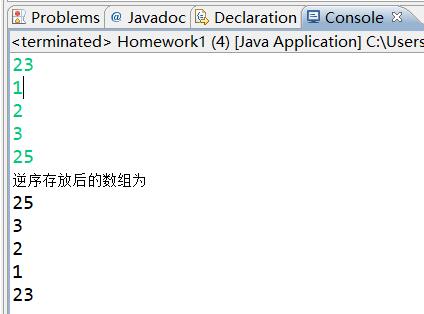
7. 将一个数组中的重复元素保留一个其他的清零。(知识点:数组遍历、数组元素访问) [选作题]课后作业•
1 package work8; 2 import java.util.Scanner; 3 public class Homework2 { 4 5 /** 6 * @param args 7 */ 8 public static void main(String[] args) { 9 // 7. 将一个数组中的重复元素保留一个其他的清零。(知识点:数组遍历、数组元素访问) [选作题]课后作业• 10 Scanner input=new Scanner(System.in); 11 int []a=new int[8]; 12 System.out.println("请输入a数组的数据"); 13 for (int i = 0; i < a.length; i++) { 14 a[i]=input.nextInt(); 15 } 16 for (int i = 0; i < a.length; i++) { 17 System.out.println(a[i]); 18 } 19 System.out.println("重复元素清零后的数组a为"); 20 for (int i = 0; i < a.length; i++) { 21 for (int j = 0; j < a.length; j++) { 22 if (a[i]==a[j]&&i!=j) { 23 a[j]=0; 24 } 25 } 26 System.out.println(a[i]); 27 } 28 29 } 30 31 }
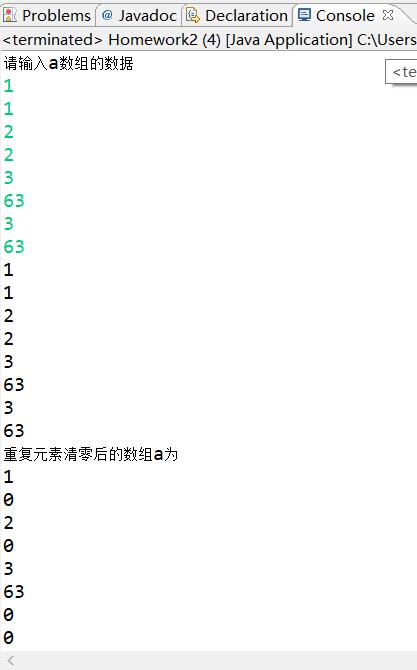
8、给定一维数组{ -10,2,3,246,-100,0,5},计算出数组中的平均值、最大值、最小值。(知识点:数组遍历、数组元素访问)
1 package work8; 2 3 public class Homework3 { 4 5 /** 6 * @param args 7 */ 8 public static void main(String[] args) { 9 // 8、给定一维数组{ -10,2,3,246,-100,0,5},计算出数组中的平均值、最大值、最小值。(知识点:数组遍历、数组元素访问) 10 int []a=new int[]{-10,2,3,246,-100,0,5}; 11 int max=a[0],min=a[0],sum=0; 12 for (int i = 0; i < a.length; i++) { 13 sum+=a[i]; 14 if (max<a[i]) { 15 max=a[i]; 16 } 17 if (min>a[i]) { 18 min=a[i]; 19 } 20 21 } 22 System.out.println("最大值为"+max); 23 System.out.println("最小值为"+min); 24 System.out.println("平均值为"+sum*1.0/a.length); 25 26 } 27 28 }
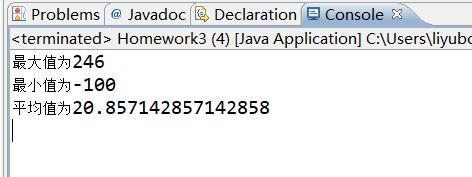
9、使用数组存放裴波那契数列的前20项 ,并输出
1 package work8; 2 3 public class Homework4 { 4 5 /** 6 * @param args 7 */ 8 public static void main(String[] args) { 9 // 9、使用数组存放裴波那契数列的前20项 ,并输出 10 int []a=new int[20]; 11 a[0]=1; 12 a[1]=1; 13 for (int i = 2; i < a.length; i++) { 14 a[i]=a[i-2]+a[i-1]; 15 } 16 for (int i = 0; i < a.length; i++) { 17 System.out.println(a[i]); 18 } 19 20 } 21 22 }
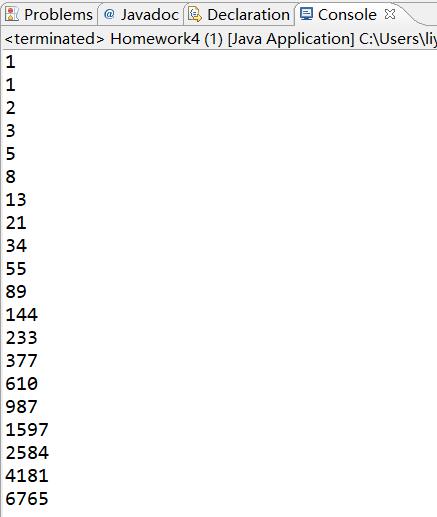
10、生成一个长度为10的随机整数数组(每个数都是0-100之间),输出,排序后,再输出
1 package work8; 2 import java.util.Random; 3 public class Homework5 { 4 5 /** 6 * @param args 7 */ 8 public static void main(String[] args) { 9 // 10、生成一个长度为10的随机整数数组(每个数都是0-100之间),输出,排序后,再输出 10 Random r=new Random(); 11 int []a=new int[10]; 12 for (int i = 0; i < a.length; i++) { 13 a[i]=r.nextInt(100); 14 System.out.println(a[i]); 15 } 16 java.util.Arrays.sort(a); 17 System.out.println("排序后"); 18 for (int i = 0; i < a.length; i++) { 19 System.out.println(a[i]); 20 } 21 22 } 23 24 }



